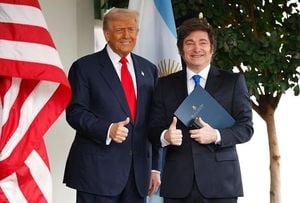In a week marked by high-stakes diplomacy and cautious optimism, the United States and China signaled a remarkable shift in their relationship, culminating in a series of agreements that could reshape the trajectory of global security and economic cooperation. On November 4, 2025, Chinese President Xi Jinping and U.S. President Donald Trump convened for a summit described by many observers as a breakthrough, with China treated as an “equal partner” on the world stage, according to Bloomberg. The significance of this meeting was underscored by David Daokui Li, a regular policy adviser to Beijing, who called it “really historical,” adding, “Among all the meetings between the two leaders, this one is perhaps the most important.”
The headline announcement from the summit was the joint commitment by both nations to “work together” to resolve the ongoing war between Russia and Ukraine. While the specifics of their collaboration remain under wraps, President Trump told reporters that the two sides had agreed to “get the war with Russia and Ukraine solved.” Analysts across the globe are now watching closely, as China’s involvement could dramatically alter the diplomatic landscape surrounding the conflict. The move is seen as a potential game-changer, given Beijing’s influence in Moscow and its growing stature in international affairs.
Beyond the Ukraine crisis, the summit yielded a one-year trade truce, including agreements on tariffs and the export control of critical minerals. These economic measures are not just about dollars and cents—they’re about trust, leverage, and the delicate balance of power between the world’s two largest economies. For months, the U.S. has been signaling its intent to reduce reliance on China in strategic sectors, while also shoring up alliances in response to Russia’s actions in Ukraine. The agreements reached this week suggest a tentative pause in the economic skirmishes that have defined the relationship in recent years, at least for now.
But perhaps the most intriguing development is China’s anticipated engagement in security issues, particularly regarding Ukraine. According to Bloomberg, there is “visible enthusiasm” in Beijing following the summit, and a recent post by Xi Jinping’s chief of staff, Cai Qi, referencing “proactive management of the international space,” reflects China’s growing confidence in its global role. Many in Beijing see this as a moment when China is stepping up—no longer content to simply react to world events, but actively shaping them.
The diplomatic flurry didn’t end with the presidential summit. On November 2, 2025, U.S. Secretary of War Pete Hegseth met with China’s Minister of National Defense, Admiral Dong Jun. The two defense leaders agreed to establish direct military-to-military communication channels, a move designed to “deconflict and deescalate” any potential problems that might arise between the two powers. Hegseth described the meeting as “positive,” noting that both sides agreed the best path forward involves “peace, stability, and good relations.” In a message posted on X, Hegseth expressed optimism, saying, “Admiral Dong and I also agreed that we should set up military-to-military channels to deconflict and deescalate any problems that arise. We have more meetings on that coming soon. God bless both China and the USA!”
This agreement is particularly notable given the backdrop of rising tensions in the Asia-Pacific region, especially in the contested waters of the South China Sea. Earlier that same day, Hegseth attended a meeting in Malaysia with defense leaders from the Association of Southeast Asian Nations (ASEAN), where he urged regional partners to push back against what he called Beijing’s “aggressive actions.” According to The Associated Press, Hegseth was blunt: “China’s sweeping territorial and maritime claims in the South China Sea fly in the face of their commitments to resolve disputes peacefully.” He added, “We seek peace. We do not seek conflict. But we must ensure that China is not seeking to dominate you or anybody else.”
The South China Sea remains a powder keg, with China, the Philippines, Vietnam, Malaysia, and Brunei all laying claim to overlapping territories. Clashes between Chinese maritime forces and the Philippines have become more frequent, with Beijing recently labeling the Philippines a “troublemaker” for conducting joint naval and air drills with the U.S., Australia, and New Zealand. The situation escalated further when China designated the Scarborough Shoal—a territory seized from the Philippines in 2012—as a “nature reserve.” Hegseth didn’t mince words, calling the move “yet another attempt to coerce new and expanded territorial and maritime claims at your expense.”
To counter these tensions, Hegseth proposed a series of measures to ASEAN leaders, including the creation of a “shared maritime domain awareness” network and rapid-response systems to deter provocations. “We must ensure that any member facing aggression and provocation is not alone,” he told the gathering, according to The Associated Press. These proposals, if enacted, would mark a significant step toward greater collective security in a region often caught between the competing interests of major powers.
In a further sign of deepening cooperation, Hegseth welcomed plans for an ASEAN-U.S. maritime exercise scheduled for December 2025. The exercise aims to strengthen coordination and safeguard the freedom of navigation—a principle the U.S. has long championed in the face of China’s expansive maritime claims. Regional leaders hope the exercise will serve as both a deterrent to future provocations and a symbol of unity against coercion.
While the agreements and proposals announced this week are promising, the path ahead remains fraught with challenges. The details of the U.S.-China plan to address the Russia-Ukraine war are still unknown, and skeptics caution that the devil will be in the details. Moreover, while the establishment of military hotlines is a step in the right direction, it will take time to build the trust and transparency needed to prevent miscalculations or unintended confrontations.
Still, there is a palpable sense of momentum. In Beijing, the mood is buoyant, with officials openly discussing China’s new role as a proactive manager of international affairs. In Washington, the emphasis is on pragmatic engagement—balancing cooperation where possible with vigilance where necessary. For Southeast Asian nations, the renewed U.S. focus on regional security is a welcome development, though many remain wary of being caught in the crossfire of great-power competition.
This week’s diplomatic breakthroughs, then, represent more than just a pause in hostilities or a temporary truce. They offer a glimpse of what’s possible when rival powers choose dialogue over confrontation, and when the world’s most consequential relationship is guided—however briefly—by the promise of partnership rather than the shadow of rivalry.
As the dust settles from these landmark meetings, the world watches with cautious hope. The decisions made in Beijing, Washington, and Kuala Lumpur could well determine the shape of global order for years to come.




